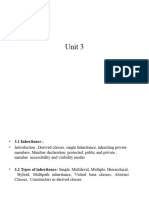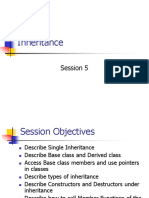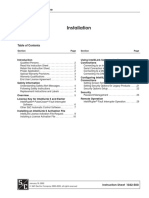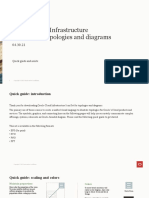Inheritance:
Reaccessability is yet another feature of OOP's. C++ strongly supports the concept of reusability.
The C++ classes can be used again in several ways. Once a class has been written and tested, it can
be adopted by another programmers. This is basically created by defining the new classes, reusing
the properties of existing ones. The mechanism of deriving a new class from an old one is called
'INHERTTENCE'. This is often referred to as IS-A' relationship because very object of the class
being defined "is" also an object of inherited class. The old class is called 'BASE' class and the new
one is called'DERIEVED'class.
Defining Derived Classes
A derived class is specified by defining its relationship with the base class in addition to its own
details. The general syntax of defining a derived class is as follows:
class d_classname : Access specifier baseclass name
{
// members of derived class
};
The colon indicates that the a-class name is derived from the base class name. The access specifier or
the visibility mode is optional and, if present, may be public, private or protected. By default it is
private. Visibility mode describes the status of derived features e.g.
class xyz //base class
{
members of xyz
};
class ABC : public xyz //public derivation
{
members of ABC
};
class ABC : XYZ //private derivation (by default)
{
members of ABC
};
In the inheritance, some of the base class data elements and member functions are inherited into the
derived class. We can add our own data and member functions and thus extend the functionality of the
base class. Inheritance, when used to modify and extend the capabilities of the existing classes,
becomes a very powerful tool for incremental program development.
Single Inheritance
When a class inherits from a single base class, it is known as single inheritance. Following program
shows the single inheritance using public derivation.
#include<iostream.h>
#include<conio.h>
class worker
{
int age;
char name [10];
public:
void get ( );
};
void worker : : get ( )
{
cout <<”yout name please”
cin >> name;
cout <<”your age please” ;
cin >> age;
}
void worker :: show ( )
{
cout <<”In My name is :”<<name<<”In My age is :”<<age;
}
class manager :: public worker //derived class (publicly)
{
int now;
public:
void get ( ) ;
void show ( ) ;
};
void manager : : get ( )
{
worker : : get ( ) ; //the calling of base class input fn.
cout << “number of workers under you”;
cin >> now;
cin>>name>>age;
} ( if they were public )
void manager :: show ( )
{
worker :: show ( ); //calling of base class o/p fn.
cout <<“in No. of workers under me are: “ << now;
}
main ( )
{
clrscr ( ) ;
worker W1;
manager M1;
M1 .get ( );
M1.show ( ) ;
}
If you input the following to this program:
Your name please
Ravinder
Your age please
27
number of workers under you
30
Then the output will be as follows:
My name is : Ravinder
My age is : 27
No. of workers under me are : 30
The following program shows the single inheritance by private derivation.
#include<iostream.h>
#include<conio.h>
class worker //Base class declaration
{
int age;
char name [10] ;
public:
void get ( ) ;
void show ( ) ;
};
void worker : : get ( )
{
cout << “your name please” ;
cin >> name;
cout << “your age please”;
cin >>age;
}
void worker : show ( )
{
cout << “in my name is: “ <<name<< “in” << “my age is : “ <<age;
}
class manager : worker //Derived class (privately by default)
{
int now;
public:
void get ( ) ;
void show ( ) ;
};
void manager : : get ( )
{
worker : : get ( ); //calling the get function of base
cout << “number of worker under you”; class which is
cin >> now;
}
void manager : : show ( )
{
worker : : show ( ) ;
cout << “in no. of worker under me are : “ <<now;
}
main ( )
{
clrscr ( ) ;
worker wl ;
manager ml;
ml.get ( ) ;
ml.show ( );
}
The following program shows the single inheritance using protected derivation
#include<conio.h>
#include<iostream.h>
class worker //Base class declaration
{ protected:
int age; char name [20];
public:
void get ( );
void show ( );
};
void worker :: get ( )
{
cout >> “your name please”;
cin >> name;
cout << “your age please”;
cin >> age;
}
void worker :: show ( )
{
cout << “in my name is: “ << name << “in my age is “ <<age;
}
class manager:: protected worker // protected inheritance
{
int now;
public:
void get ( );
void show ( ) ;
};
void manager : : get ( )
{
cout << “please enter the name In”;
cin >> name;
cout<< “please enter the age In”; //Directly inputting the data
cin >> age; members of base class
cout << “ please enter the no. of workers under you:”;
cin >> now;
}
void manager : : show ( )
{
cout « "your name is : "«name«" and age is : "«age;
cout «"In no. of workers under your are : "«now;
main ( )
{
clrscr ( ) ;
manager ml;
ml.get ( ) ;
cout « "\n \n";
ml.show ( );
}
Making a Private Member Inheritable
Basically we have visibility modes to specify that in which mode you are deriving the another class
from the already existing base class. They are:
a. Private: when a base class is privately inherited by a derived class, 'public members'
of the base class become private members of the derived class and therefore the
public members of the base class can be accessed by its own objects using the
dot operator. The result is that we have no member of base class that is accessible
to the objects of the derived class.
b. Public: On the other hand, when the base class is publicly inherited, 'public members'
of the base class become 'public members' of derived class and therefore they are
accessible to the objects of the derived class.
c. Protected: C++ provides a third visibility modifier, protected, which serve a little
purpose in the inheritance. A member declared as protected is accessible by the
member functions within its class and any class immediately derived from it. It
cannot be accessed by functions outside these two classes.
The below mentioned table summarizes how the visibility of members undergo modifications when
they are inherited
Base Class Visibility Derived Class Visibility
Public Private Protected
Private X X X
Public Public Private Protected
Protected Protected Private Protected
The private and protected members of a class can be accessed by:
a. A function i.e. friend of a class.
b. A member function of a class that is the friend of the class.
c. A member function of a derived class.
Student Activity
1. Define Inheritance. What is the inheritance mechanism in C++?
2. What are the advantage of Inheritance?
3. What should be the structure of a class when it has to be a base for other classes?
LECTURE-27
Multilevel Inheritance
When the inheritance is such that, the class A serves as a base class for a derived class B which in turn
serves as a base class for the derived class C. This type of inheritance is called ‘MULTILEVEL
INHERITENCE’. The class B is known as the ‘INTERMEDIATE BASE CLASS’ since it provides a
link for the inheritance between A and C. The chain ABC is called ‘ITNHERITENCE*PATH’ for e.g.
A Base class
Inheritance path B Intermediate base
class
C Derived class
The declaration for the same would be:
Class A
{
//body
}
Class B : public A
{
//body
}
Class C : public B
{
//body
}
This declaration will form the different levels of inheritance.
Following program exhibits the multilevel inheritance.
#include<iostream.h>
#include<conio.h>
class worker // Base class declaration
{
int age;
char name [20] ;
public;
void get( ) ;
void show( ) ;
}
void worker: get ( )
{
cout << “your name please” ;
cin >> name;
cout << “your age please” ;
}
void worker : : show ( )
{
cout << “In my name is : “ <<name<< “ In my age is : “ <<age;
}
class manager : public worker //Intermediate base class derived
{ //publicly from the base class
int now;
public:
void get ( ) ;
void show( ) ;
};
void manager :: get ( )
{
worker : :get () ; //calling get ( ) fn. of base class
cout << “no. of workers under you:”;
cin >> now;
}
void manager : : show ( )
{
worker : : show ( ) ; //calling show ( ) fn. of base class
cout << “In no. of workers under me are: “<< now;
}
class ceo: public manager //declaration of derived class
{ //publicly inherited from the
int nom; //intermediate base class
public:
void get ( ) ;
void show ( ) ;
};
void ceo : : get ( )
{
manager : : get ( ) ;
cout << “no. of managers under you are:”; cin >> nom;
}
void manager : : show ( )
{
cout << “In the no. of managers under me are: In”;
cout << “nom;
}
main ( )
{
clrscr ( ) ;
ceo cl ;
cl.get ( ) ; cout << “\n\n”;
cl.show ( ) ;
}
Worker
Private:
int age;
char name[20];
Protected:
Private:
int age;
char name[20];
Manager:Worker
Private:
int now;
Protected:
Public:
void get()
void show()
worker ::get()
worker ::get()
Ceo: Manager
Public:
Protected:
Public:
All the inherited
members
Multiple Inheritances
A class can inherit the attributes of two or more classes. This mechanism is known as ‘MULTIPLE
INHERITENCE’. Multiple inheritance allows us to combine the features
of several existing classes as a starring point for defining new classes. It is like the child inheriting the
physical feature of one parent and the intelligence of another. The syntax of the derived class is as
follows:
Class base1 Class base2
{ {
//body1 // body2
} }
Class derived : visibility basel, visibility base2
{
//body3
}
Where the visibility refers to the access specifiers i.e. public, private or protected. Following program
shows the multiple inheritance.
#include<iostream.h>
#include<conio . h>
class father //Declaration of base classl
{
int age ;
char flame [20] ;
public:
void get ( ) ;
void show ( ) ;
};
void father : : get ( )
{
cout << “your father name please”;
cin >> name;
cout << “Enter the age”;
cin >> age;
}
void father : : show ( )
{
cout<< “In my father’s name is: ‘ <<name<< “In my father’s age is:<<age;
}
class mother //Declaration of base class 2
{
char name [20] ;
int age ;
public:
void get ( )
{
cout << “mother’s name please” << “In”;
cin >> name;
cout << “mother’s age please” << “in”;
cin >> age;
}
void show ( )
{
cout << “In my mother’s name is: “ <<name;
cout << “In my mother’s age is: “ <<age;
}
class daughter : public father, public mother //derived class inheriting
{ //publicly
char name [20] ; //the features of both the base class
int std;
public:
void get ( ) ;
void show ( ) ;
};
void daughter :: get ( )
{
father :: get ( ) ;
mother :: get ( ) ;
cout << “child's name: “;
cin >> name;
cout << “child's standard”;
cin >> std;
}
void daughter :: show ( )
{
father :: show ( );
nfather :: show ( ) ;
cout << “In child’s name is : “ <<name;
cout << “In child's standard: “ << std;
}
main ( )
{
clrscr ( ) ;
daughter d1;
d1.get ( ) ;
d1.show ( ) ;
}
Diagrammatic Representation of Multiple Inheritance is as follows:
Father Mother
Private: Private:
int age; int age;
char name[20]; char name[20];
Protected: Protected:
Public: Public:
void get() void get()
void show() void show()
Class daughter: public Father, public Mother
Private: char name[20]; int age;
Protected:
Public:
//self
void get(); void showQ;
//from Father
void get(); void show();
//from Mother
void get(); void show();
LECTURE-28
Hierarchical Inheritance
Another interesting application of inheritance is to use is as a support to a hierarchical design of a class
program. Many programming problems can be cast into a hierarchy where certain features of one level
are shared by many others below that level for e.g.
Accounts
Saving Accounts Current Accounts
Fixed deposit
Short term Long term
Mid term
In general the syntax is given as
Class A
{
// body A
}
Class B: public A Class C: public A
{ {
//body B //body B
} }
In C++, such problems can be easily converted into hierarchies. The base class will include all the
features that are common to the subclasses. A sub-class can be constructed by inheriting the features
of base class and so on.
// Program to show the hierarchical inheritance
#include<iostream.h>
# include<conio. h>
class father //Base class declaration
{
int age;
char name [15];
public:
void get ( )
{
cout<< “father name please”; cin >> name;
cout<< “father’s age please”; cin >> age;
}
void show ( )
{
cout << “In father’s name is ‘: “<<name;
cout << “In father’s age is: “<< age;
}
};
class son : public father //derived class 1
{
char name [20] ;
int age ;
public;
void get ( ) ;
void show ( ) ;
};
void son : : get ( )
{
father :: get ( ) ;
cout << “your (son) name please” << “in”; cin >>name;
cout << “your age please” << “ln”; cin>>age;
}
void son :: show ( )
{
father : : show ( ) ;
cout << “In my name is : “ <<name;
cout << “In my age is : “ <<age;
}
class daughter : public father //derived class 2.
{
char name [15] ;
int age;
public:
void get ( )
{
father : : get ( ) ;
cout << “your (daughter’s) name please In” cin>>name;
cout << “your age please In”; cin >>age;
}
void show ( )
{
father : : show ( ) ;
cout << “in my father name is: “ << name << “
In and his age is : “<<age;
}
};
main ( )
{
clrscr ( ) ;
son S1;
daughter D1 ;
S1. get ( ) ;
D1. get ( ) ;
S1 .show( ) ;
D1. show ( ) ;
}
Hybrid Inheritance
There could be situations where we need to apply two or more types of inheritance to design a program.
Basically Hybrid Inheritance is the combination of one or more types of the inheritance. Here is one
implementation of hybrid inheritance.
//Program to show the simple hybrid inheritance
#include<i sos t ream. h>
#include<conio . h>
class student //base class declaration
{
protected:
int r_no;
public:
void get _n (int a)
{
r_no =a;
}
void put_n (void)
{
cout << “Roll No. : “<< r_no;
cout << “In”;
}
};
class test : public student
{ //Intermediate base class
protected : int parti, par 2;
public :
void get_m (int x, int y) {
parti = x; part 2 = y; }
void put_m (void) {
cout << “marks obtained: “ << “In”
<< “Part 1 = “ << part1 << “in”
<< “Part 2 = “ << part2 << “In”;
}
};
class sports // base for result
{
protected : int score;
public:
void get_s (int s) {
score = s }
void put_s (void) {
cout << “ sports wt. : “ << score << “\n\n”;
}
};
class result : public test, public sports //Derived from test
& sports
{
int total;
public:
void display (void);
};
void result : : display (void)
{
total = part1 + part2 + score;
put_n ( ) ;.
put_m ( );
put_S ( );
cout << “Total score: “ <<total<< “\n”
}
main ( )
{
clrscr ( ) ;
result S1;
S1.get_n (347) ;
S1.get_m (30, 35);
S1.get_s (7) ;
S1.dciplay ( ) ;
}
Student Activity
1. What is the major use of multilevel Inheritance?
2. How are arguments sent to the base constructors in multiple inheritance? Whose
responsibility is it.
3. What is the difference between hierarchical and hybrid Inheritance.
























































































